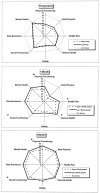Laparoscopic versus open gastric bypass: a randomized study of outcomes, quality of life, and costs
- PMID: 11524581
- PMCID: PMC1422019
- DOI: 10.1097/00000658-200109000-00002
Laparoscopic versus open gastric bypass: a randomized study of outcomes, quality of life, and costs
Abstract
Objective: To compare outcomes, quality of life (QOL), and costs of laparoscopic and open gastric bypass (GBP).
Summary background data: Laparoscopic GBP has been reported to be a safe and effective approach for the treatment of morbid obesity. The authors performed a prospective randomized trial to compare outcomes, QOL, and costs of laparoscopic GBP with those of open GBP.
Methods: From May 1999 to March 2001, 155 patients with a body mass index (BMI) of 40 to 60 kg/m2 were randomly assigned to undergo laparoscopic (n = 79) or open (n = 76) GBP. The two groups were similar in age, sex ratio, mean BMI, and comorbidities. Main outcome measures included operative time, estimated blood loss, length of hospital stay, operative complications, percentage of excess body weight loss, and time to return to activities of daily living and work. Changes in QOL were assessed using the SF-36 Health Survey and the bariatric analysis of reporting outcome system (BAROS). Operative and hospital costs of the two operations were also compared.
Results: There were no deaths in either group. Mean operative time was longer for laparoscopic GBP than for open GBP, but operative blood loss was less. Two (2.5%) of the 79 patients in the laparoscopic group required conversion to laparotomy. Median length of hospital stay was shorter for laparoscopic GBP patients (3 vs 4 days). The rate of postoperative anastomotic leak was similar between groups. Wound-related complications such as infection (10.5 vs 1.3%) and incisional hernia (7.9 vs 0%) were more common after open GBP; late anastomotic stricture was less frequent after open GBP (2.6 vs 11.4%). Time to return to activities of daily living and work were shorter after laparoscopic GBP than after open GBP. Weight loss at 1 year was similar between groups. Preoperative SF-36 scores were similar between groups; however, at 1 month after surgery, laparoscopic patients had better physical conditioning, social functioning, general health, and less body pain than open GBP patients. At 6 months, the BAROS outcome was classified as good or better in 97% of laparoscopic GBP patients compared with 82% of open GBP patients. Operative costs were higher for laparoscopic GBP patients, but hospital costs were lower.
Conclusions: Laparoscopic GBP is a safe and cost-effective alternative to open GBP. Despite a longer operative time, patients undergoing laparoscopic GBP benefited from less blood loss, a shorter hospital stay, and faster convalescence. Laparoscopic GBP patients had comparable weight loss at 1 year but a more rapid improvement in QOL than open GBP patients. The higher initial operative costs for laparoscopic GBP were adequately offset by the lower hospital costs.
Figures


References
-
- Balsiger BM, Luque deLeon EL, Sarr MG. Surgical treatment of obesity: Who is an appropriate candidate? Mayo Clin Proc 1997; 72: 551–557. - PubMed
-
- Mokdad AH, Serdula MK, Dietz WH, et al. The spread of the obesity epidemic in the United States, 1991–1998. JAMA 1999; 282: 1519–1522. - PubMed
-
- Health implications of obesity. NIH Consensus Development Conference Statement, Feb. 11–13. 1985; 5: 1–7.
-
- Choban PS, Onyejekwe J, Burge JC, et al. A health status assessment of the impact of weight loss following Roux-en-Y gastric bypass for clinically severe obesity. J Am Coll Surg 1999; 188: 491–497. - PubMed
-
- Calle EE, Thun MJ, Petrelli JM, et al. Body-mass index and mortality in a prospective cohort of U.S. adults. N Engl J Med 1999; 341: 1097–105. - PubMed
Publication types
MeSH terms
LinkOut - more resources
Full Text Sources
Other Literature Sources
Research Materials

